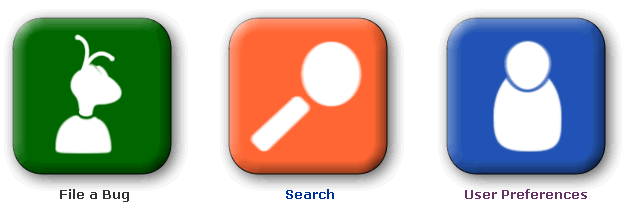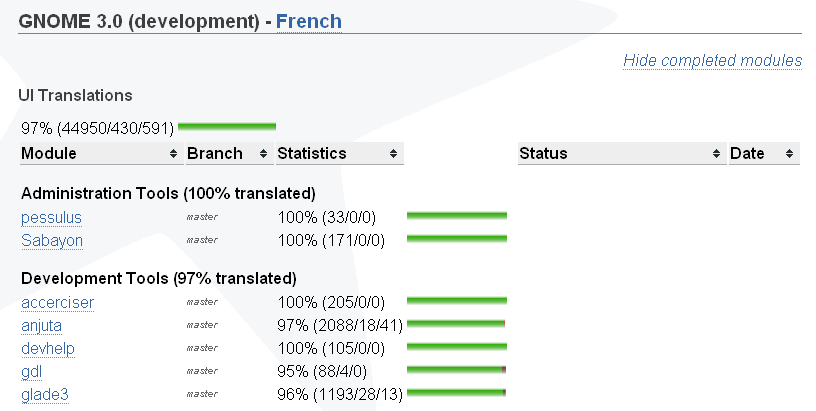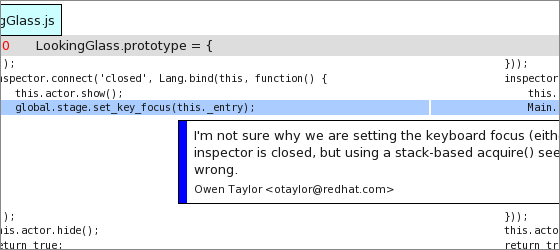GNOME3 – for the developers
7. April 2011
Together with the release of GNOME 3 the new GNOME developer center was launched today. This is just the first step to make GNOME 3 a great developer platform but I hope it is already a big step!
There is still a bunch of things missing, like proper API documentation for languages using introspection (Javascript, Python) but things got a lot better with the new platform overview and will certainly improve in the future.
I have to especially thank Fréderic Peters who did all the dirty backend work on the infrastructure in the last days & weeks so everything could be launched on time.
However, this wouldn’t have been possible without many amazing people (in no particular order): Andreas Nilson, Julie Pichon, Phil Bull, Shaun McCance, Daniel g. Siegel, Patricia Santana Cruz, Ekaterina Gerasimova, David King, Jon Nordby, Chris Kühl, Jonh Wendell, Andre Klapper, Germán Poo and P. F. Chimento, hoping I didn’t forget anyone. And of course the beautiful cities of Berlin and Toronto!
Thanks!
Why gnome.org Rocks: Translations
4. June 2010
This article is part of a series of articles about why I feel gnome.org is a great home for your Open Source project.
Translations are an important point for the success of a project. Most of the people in the world don’t have English as their first language and might not even understand it at all. Luckily a big community is taking care of that issue and translates open source software into many languages including some that would probably just die if there is not enough content for them.
gnome.org provides an extraordinary platform for translatiions called (historically) Damned lies about GNOME. It provides a variety of services and helps to keep translation teams together and productive:
- Download up-to-date POT files without having to deal with git
- Upload translations for review
- Review translation
- Managing your team by assigning modules
- Translation stats
- Automatically commit translations (coming soon hopefully…)
In addition it provides additional information for problems in the project translation infrastructure and links to translation bugs and the possibility to file new translation bugs if necessary.
Getting your app translated
There isn’t much you need to do for the Translation Project to pick up your project when it is hosted on gnome.org. Sending a reminder mail to i18n-list cannot hurt though to have your project added to damned-lies. The rest will then just happen on it’s own but be aware that translators can be picky about wording! Keep your string clear and understadable, otherwise they will bother you 😉
Why gnome.org Rocks: Great bug tracking
4. June 2010
This article is part of a series of articles about why I feel gnome.org is a great home for your Open Source project.
Bug trackers are usually an annoying things. There are always more bugs than you can cope with at a specific time and it can become horrible to keep track of the important things. It is pretty difficult to keep bugs organized and often a lot of crap accumulates in your tracker.
In addition there is no real line between bugs, features, ideas, enhancements usually so keeping them in different places just causes distraction.
Simplicity
 From the start bugzilla.gnome.org provides you a with simple interface to just do your stuff, regardless if you are user or developers. It guides you through the steps necessary to file new bugs as well as hinting you how and where to find duplicates.
From the start bugzilla.gnome.org provides you a with simple interface to just do your stuff, regardless if you are user or developers. It guides you through the steps necessary to file new bugs as well as hinting you how and where to find duplicates.
It also provides a sane way for the bug squad and for developers to mark duplicates, move bugs between different modules, set dependencies of bugs and link bugs with external resources in other bug trackers.
Speaking of the bug squad: This is a ridiculous productive team of people helping you sorting out all the crap, duplicates and unclear bugs from your module. If you want to contribute to GNOME and don’t really now where to start, they always need help.
And not to forget about the highly configurable mail interface that gives you notifications of what happens to your bugs and your project.
Overview
This is one of the strongest points of the GNOME Bugzilla: It gives you a place to start from. You now that number of bugs, the bugs needing a comment, the unreviewed patches and most important the priority of the bugs around. I haven’t seen a single bug tracker providing this information in such a nice way.
Patch review
Kudos go to Owen Taylor here! Splinter is probably the best patch review tool around with an absolutely intuitive user interface. I allows you to quickly comment on patches and to help new contributors. This is especially important as the problems are usually the little things and that it is pretty annoying to explain everything when you could just add a simple annotation here and there.
This article is part of a series of articles about why I feel gnome.org is a great home for your Open Source project.
After some discussion and a final poll gnome.org decided to got for git as version control system. git is a very powerful system and might have a higher learning curve than other DVCS but it also gives you nearly unlimited power on your code. One of the coolest features include:
- Easy local and remove branches
- Cherry-picking changes from other branches
- Edit the history
- Creating series of patches
cgit: Web inteface
Often it is extremely convenient to track the project status of something you are interested by firing up a web-browser. git.gnome.org/browse implements a very nice interface to the version history and new changes. It shows you the information you are interested hiding all the dirty details.
Add your project
As GNOME is a community project and not a hosting service, getting your project into GNOME git might look frightening first though it isn’t. Often you will start coding without the big picture of where the project will end up. Things like github are possibly a nice place to get started with prototyping when you just need code hosting.
But when you are at the point where things are working and stuffs turning out to be great, just follow the instructions and you will be amazed what will happen:
- People will file bugs if your module doesn’t build
- Translators will bother you to fix your strings and translation infrastructure
- All those little things you might have missed on first try like other platforms, other distributions and build system issues will come up on bugzilla and give you the opportunity to build an even more awesome project.
Bugzilla integration
Again it was Owen who created cool scripts to interact with bugzilla and thus don’t having to get off your work to file bugs and patches. Read his blogs post for details.
Why gnome.org
4. June 2010
Today I want to start contributing to a solution for something that has been agitating me for a while. That is, simply not enough people know who wicked-cool hosting your project on gnome.org is.
As many other people probably, I started hosting projects on sourceforge.net years ago. Over time, their infrastructure became limited. In between I used garage.maemo.org for some stuff which is nice but also limited in some way for bigger projects.
In the end, all the stuff I work on and that I maintain is hosted on gnome.org. While I never worked on any part of that infrastructure and I have high respect for all the sysadmins donating their time to such a great platform I still think we need to do better promotion for it.
Just enough goodness for my project
The gnome infrastructure is the perfect place for my projects because it gives you all the benefits of project hosting without limiting you to a specific development model. And in addition it is a great place to collaborate with other great GNOME projects.
In particular it features great solutions for the following things:
- Bug Tracking: The best bugzilla I have seen around with an awesome bugsquad taking care of all the incomplete and strange bugreports
- Code Hosting: Store your code in the git version control system and keep track of the status with the cgit web interface
- Translations: Huge number of translation teams that provide high-quality translations and damned-lies as great tool to track translation status, submit and review translations
- Mailing lists: Provides a high quality mailman interface for your mailing list including with archive and bonus features like registering your mail as post-only for all gnome lists which gives great convenience.
- Web space: Give your project a home on the web which unlimited space and fast servers.
- Wiki: Nice, easy to use and translatable space for keeping some non-code stuff for your project
All of the major and successful GNOME projects use that infrastructure regardless if driven by companies, groups or individuals.
See the list of Why gnome.org Rocks articles here.
(You might have noticed that this series looks a lot like Jono’s series on Launchpad. That’s intentional! But that doesn’t mean that I want to start a flamewar on project hosting. I just have the feeling that people don’t really understand how good our infrastructure is and I really want to change that.)



